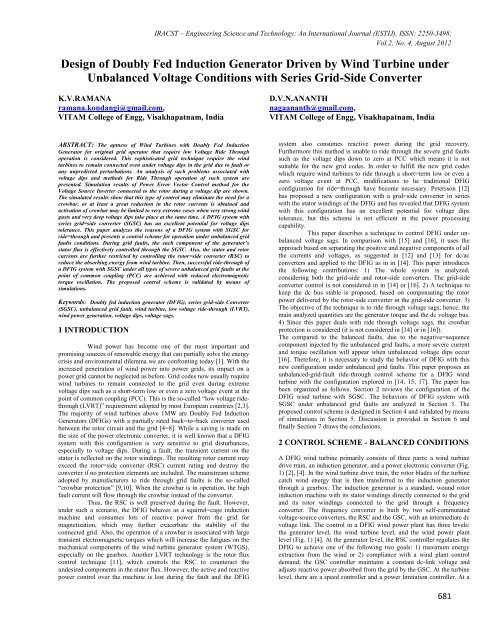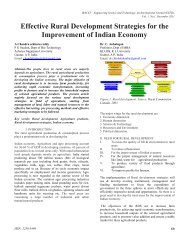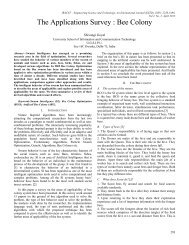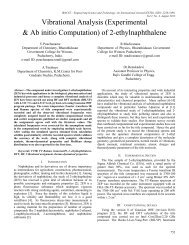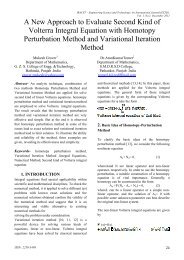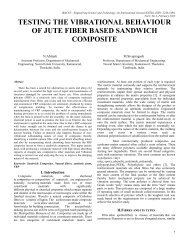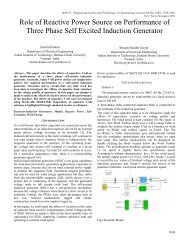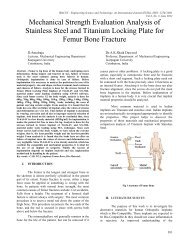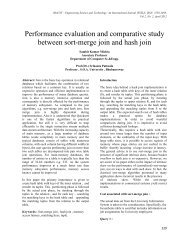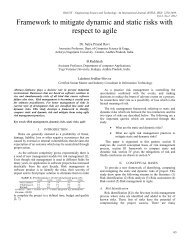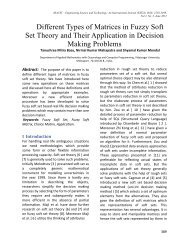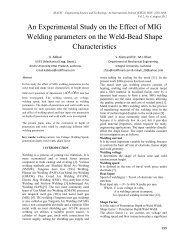Design of Doubly Fed Induction Generator Driven by Wind Turbine ...
Design of Doubly Fed Induction Generator Driven by Wind Turbine ...
Design of Doubly Fed Induction Generator Driven by Wind Turbine ...
Create successful ePaper yourself
Turn your PDF publications into a flip-book with our unique Google optimized e-Paper software.
IRACST – Engineering Science and Technology: An International Journal (ESTIJ), ISSN: 2250-3498,<br />
Vol.2, No. 4, August 2012<br />
<strong>Design</strong> <strong>of</strong> <strong>Doubly</strong> <strong>Fed</strong> <strong>Induction</strong> <strong>Generator</strong> <strong>Driven</strong> <strong>by</strong> <strong>Wind</strong> <strong>Turbine</strong> under<br />
Unbalanced Voltage Conditions with Series Grid-Side Converter<br />
K.V.RAMANA<br />
ramana.kondangi@gmail.com,<br />
VITAM College <strong>of</strong> Engg, Visakhapatnam, India<br />
D.V.N.ANANTH<br />
nagaananth@gmail.com,<br />
VITAM College <strong>of</strong> Engg, Visakhapatnam, India<br />
ABSTRACT: The aptness <strong>of</strong> <strong>Wind</strong> <strong>Turbine</strong>s with <strong>Doubly</strong> <strong>Fed</strong> <strong>Induction</strong><br />
<strong>Generator</strong> for original grid operator that require low Voltage Ride Through<br />
operation is considered. This sophisticated grid technique require the wind<br />
turbines to remain connected even under voltage dips in the grid due to fault or<br />
any unpredicted perturbations. An analysis <strong>of</strong> such problems associated with<br />
voltage dips and methods for Ride Through operation <strong>of</strong> such system are<br />
presented. Simulation results <strong>of</strong> Power Error Vector Control method for the<br />
Voltage Source Inverter connected to the rotor during a voltage dip are shown.<br />
The simulated results show that this type <strong>of</strong> control may eliminate the need for a<br />
crowbar, or at least a great reduction in the rotor currents is obtained and<br />
activation <strong>of</strong> crowbar may be limited to very extreme cases when very strong wind<br />
gusts and very deep voltage dips take place at the same time. A DFIG system with<br />
series grid=side converter (SGSC) has an excellent potential for voltage dips<br />
tolerance. This paper analyzes the reasons <strong>of</strong> a DFIG system with SGSC for<br />
ride=through and presents a control scheme for operation under unbalanced grid<br />
faults conditions. During grid faults, the each component <strong>of</strong> the generator’s<br />
stator flux is effectively controlled through the SGSC. Also, the stator and rotor<br />
currents are further restricted <strong>by</strong> controlling the rotor=side converter (RSC) to<br />
reduce the absorbing energy from wind turbine. Then, successful ride-through <strong>of</strong><br />
a DFIG system with SGSC under all types <strong>of</strong> severe unbalanced grid faults at the<br />
point <strong>of</strong> common coupling (PCC) are achieved with reduced electromagnetic<br />
torque oscillation. The proposed control scheme is validated <strong>by</strong> means <strong>of</strong><br />
simulations.<br />
Keywords: <strong>Doubly</strong> fed induction generator (DFIG), series grid-side Converter<br />
(SGSC), unbalanced grid fault, wind turbine, low voltage ride-through (LVRT),<br />
wind power generation, voltage dips, voltage sags.<br />
1 INTRODUCTION<br />
<strong>Wind</strong> power has become one <strong>of</strong> the most important and<br />
promising sources <strong>of</strong> renewable energy that can partially solve the energy<br />
crisis and environmental dilemma we are confronting today [1]. With the<br />
increased penetration <strong>of</strong> wind power into power grids, its impact on a<br />
power grid cannot be neglected as before. Grid codes now usually require<br />
wind turbines to remain connected to the grid even during extreme<br />
voltage dips such as a short-term low or even a zero voltage event at the<br />
point <strong>of</strong> common coupling (PCC). This is the so-called “low voltage ridethrough<br />
(LVRT)” requirement adopted <strong>by</strong> most European countries [2,3].<br />
The majority <strong>of</strong> wind turbines above 1MW are <strong>Doubly</strong> <strong>Fed</strong> <strong>Induction</strong><br />
<strong>Generator</strong>s (DFIGs) with a partially rated back=to=back converter used<br />
between the rotor circuit and the grid [4=8]. While a saving is made on<br />
the size <strong>of</strong> the power electronic converter, it is well known that a DFIG<br />
system with this configuration is very sensitive to grid disturbances,<br />
especially to voltage dips. During a fault, the transient current on the<br />
stator is reflected on the rotor windings. The resulting rotor current may<br />
exceed the rotor=side converter (RSC) current rating and destroy the<br />
converter if no protection elements are included. The mainstream scheme<br />
adopted <strong>by</strong> manufacturers to ride through grid faults is the so-called<br />
“crowbar protection” [9,10]. When the crowbar is in operation, the high<br />
fault current will flow through the crowbar instead <strong>of</strong> the converter.<br />
Thus, the RSC is well preserved during the fault. However,<br />
under such a scenario, the DFIG behaves as a squirrel=cage induction<br />
machine and consumes lots <strong>of</strong> reactive power from the grid for<br />
magnetization, which may further exacerbate the stability <strong>of</strong> the<br />
connected grid. Also, the operation <strong>of</strong> a crowbar is associated with large<br />
transient electromagnetic torques which will increase the fatigues on the<br />
mechanical components <strong>of</strong> the wind turbine generator system (WTGS),<br />
especially on the gearbox. Another LVRT technology is the rotor flux<br />
control technique [11], which controls the RSC to counteract the<br />
undesired components in the stator flux. However, the active and reactive<br />
power control over the machine is lost during the fault and the DFIG<br />
system also consumes reactive power during the grid recovery.<br />
Furthermore this method is unable to ride through the severe grid faults<br />
such as the voltage dips down to zero at PCC which means it is not<br />
suitable for the new grid codes. In order to fulfill the new grid codes<br />
which require wind turbines to ride through a short=term low or even a<br />
zero voltage event at PCC, modifications to he traditional DFIG<br />
configuration for ride=through have become necessary. Petersson [12]<br />
has proposed a new configuration with a grid=side converter in series<br />
with the stator windings <strong>of</strong> the DFIG and has revealed that DFIG system<br />
with this configuration has an excellent potential for voltage dips<br />
tolerance, but this scheme is not efficient in the power processing<br />
capability.<br />
This paper describes a technique to control DFIG under unbalanced<br />
voltage sags. In comparison with [15] and [16], it uses the<br />
approach based on separating the positive and negative components <strong>of</strong> all<br />
the currents and voltages, as suggested in [12] and [13] for dc/ac<br />
converters and applied to the DFIG as in in [14]. This paper introduces<br />
the following contributions: 1) The whole system is analyzed,<br />
considering both the grid-side and rotor-side converters. The grid-side<br />
converter control is not considered in in [14] or [16]. 2) A technique to<br />
keep the dc bus stable is proposed, based on compensating the rotor<br />
power delivered <strong>by</strong> the rotor-side converter in the grid-side converter. 3)<br />
The objective <strong>of</strong> the technique is to ride through voltage sags; hence, the<br />
main analyzed quantities are the generator torque and the dc voltage bus.<br />
4) Since this paper deals with ride through voltage sags, the crowbar<br />
protection is considered (it is not considered in [14] or in [16]).<br />
The compared to the balanced faults, due to the negative=sequence<br />
component injected <strong>by</strong> the unbalanced grid faults, a more severe current<br />
and torque oscillation will appear when unbalanced voltage dips occur<br />
[16]. Therefore, it is necessary to study the behavior <strong>of</strong> DFIG with this<br />
new configuration under unbalanced grid faults. This paper proposes an<br />
unbalanced-grid-fault ride-through control scheme for a DFIG wind<br />
turbine with the configuration explored in [14, 15, 17]. The paper has<br />
been organized as follows. Section 2 reviews the configuration <strong>of</strong> the<br />
DFIG wind turbine with SGSC. The behaviors <strong>of</strong> DFIG system with<br />
SGSC under unbalanced grid faults are analyzed in Section 3. The<br />
proposed control scheme is designed in Section 4 and validated <strong>by</strong> means<br />
<strong>of</strong> simulations in Section 5. Discussion is provided in Section 6 and<br />
finally Section 7 draws the conclusions.<br />
2 CONTROL SCHEME - BALANCED CONDITIONS<br />
A DFIG wind turbine primarily consists <strong>of</strong> three parts: a wind turbine<br />
drive train, an induction generator, and a power electronic converter (Fig.<br />
1) [2], [4]. In the wind turbine drive train, the rotor blades <strong>of</strong> the turbine<br />
catch wind energy that is then transferred to the induction generator<br />
through a gearbox. The induction generator is a standard, wound rotor<br />
induction machine with its stator windings directly connected to the grid<br />
and its rotor windings connected to the grid through a frequency<br />
converter. The frequency converter is built <strong>by</strong> two self-commutated<br />
voltage-source converters, the RSC and the GSC, with an intermediate dc<br />
voltage link. The control in a DFIG wind power plant has three levels:<br />
the generator level, the wind turbine level, and the wind power plant<br />
level (Fig. 1) [4]. At the generator level, the RSC controller regulates the<br />
DFIG to achieve one <strong>of</strong> the following two goals: 1) maximum energy<br />
extraction from the wind or 2) compliance with a wind plant control<br />
demand; the GSC controller maintains a constant dc-link voltage and<br />
adjusts reactive power absorbed from the grid <strong>by</strong> the GSC. At the turbine<br />
level, there are a speed controller and a power limitation controller. At a<br />
681
IRACST – Engineering Science and Technology: An International Journal (ESTIJ), ISSN: 2250-3498,<br />
Vol.2, No. 4, August 2012<br />
low wind speed, the speed controller gives a power reference to the RSC<br />
based on the principle <strong>of</strong> maximum energy extraction. At a high wind<br />
speed, the power limitation controller increases or decreases the pitch<br />
angle <strong>of</strong> the turbine blades to prevent the wind turbine from going over<br />
the rated power. At the wind power plant level, the power production <strong>of</strong><br />
the entire plant is determined based on a grid requirement. The central<br />
control system sends out power references to each individual turbine,<br />
while the local turbine control system ensures that the power reference<br />
from the central control level is reached.<br />
A. GSC Transient and Steady-State Models<br />
Fig. 2 shows the schematic <strong>of</strong> the GSC, in which a dc-link capacitor is on<br />
the left and a three-phase voltage source, representing the voltage at the<br />
point <strong>of</strong> common coupling (PCC) <strong>of</strong> the ac system, is on the right. In the<br />
grid-side converter, the dc bus voltage and reactive power references<br />
determine the current references, which determine the voltages to be<br />
applied in the grid side.1) System Equations: In a synchronous reference<br />
frame, the grid-side voltage equations can be written as<br />
B. Rotor-Side Converter<br />
In the rotor-side converter, the referenced torque and reactive power<br />
determine the current references, which determine the voltages to be<br />
applied in the rotor side.<br />
1) Machine Equations: It is usually assumed that when the stator<br />
and rotor windings are placed sinusoidally and symmetrically,<br />
the magnetical saturation effects and the capacitance <strong>of</strong> all the<br />
windings are negligible. The relation between voltages and<br />
currents on a synchronous reference qd can be written as<br />
Linkage fluxes can be written as<br />
The torque can expressed as<br />
The reactive power yields<br />
Fig. 1. General system scheme.<br />
Active and reactive power provided <strong>by</strong> the grid-side converter can be<br />
written as Pz =3/2(vzq ilq + vzd ild) and Qz =3/2(vzq ild − vzd ilq ).The<br />
dc bus voltage can be expressed as<br />
2) Reference Quantities: The grid-side converter controls the reactive<br />
power and dc bus voltage. The q-axis may be aligned to the grid voltage<br />
allowing active and reactive decoupled control. To control the reactive<br />
power, a i ld reference is computed as<br />
2) Reference Quantities: Orientating the synchronous reference<br />
qd with the stator flux vector so that λ sd =0,therotor current<br />
references can be computed as<br />
Current Loops Implementation: The control <strong>of</strong> the current is done <strong>by</strong><br />
linearizing the current dynamics using the following state feedback.<br />
By neglecting stator current transients, the decoupling leads to<br />
C. Current Controllers Tuning<br />
Controllers have been designed using the so-called internal mode control<br />
(IMC) methodology detailed in [19]. The parameters <strong>of</strong> a PI controller to<br />
obtain a desired time constant τ are obtained as<br />
The active power, which is responsible for the evolution <strong>of</strong> the dc bus<br />
voltage, is controlled <strong>by</strong> the i lq component. A linear controller is usually<br />
designed to control the dc bus voltage. 3) Current Loops Implementation:<br />
The current control is done <strong>by</strong> the following state linearization feedback<br />
[18]:<br />
where the ˆvlq and ˆvld are the output voltages <strong>of</strong> the current controller.<br />
The decoupling leads to<br />
The currents and voltages have been limited according to the converter<br />
operating limits. PI controllers have been designed with anti-windup in<br />
order to prevent control instabilities when the controllerexceed the limit<br />
values.<br />
D. Crowbar Protection<br />
The so-called crowbar is connected to avoid over voltages in the dc bus<br />
due to excessive power flowing from the rotor inverter to the grid-side<br />
converter, guaranteeing ride through operation <strong>of</strong> the generator when<br />
voltage sags or other disturbances occur. The crowbar is triggered when<br />
682
IRACST – Engineering Science and Technology: An International Journal (ESTIJ), ISSN: 2250-3498,<br />
Vol.2, No. 4, August 2012<br />
the dc voltage reaches a thresh-old vcrow−c and disconnects when it goes<br />
below another thresh-old vcrow−d .<br />
During its operation, the rotor-side converter may be disconnected, as<br />
described in [20], or be kept connected [9] to avoid losing control over<br />
the machine. In this paper, the rotor-side converter is kept connected.<br />
Crowbar operation is a temporary measure developed as a<br />
rotor circuit protection device, long before the advent <strong>of</strong> wind turbine<br />
grid-code regulations. The term describes any device that connects<br />
together the rotor windings <strong>of</strong> a wound-rotor machine in a closed circuit<br />
through a designated resistance, diverting current from the rotor-side<br />
converter, and rapidly deenergizing the rotor. The crowbar absorbs the<br />
initial energy outflow from the machine, while the resistance shortens the<br />
effective decay timescale <strong>of</strong> the rotor flux decay, hence hastening the<br />
demagnetization process. Conventionally, the crowbar is applied for an<br />
extended duration to fully demagnetize the rotor [24], [25]. A crowbar<br />
activation period typically lasts about 120 ms. Unfortunately, this can<br />
lead to a 100-ms postfault period <strong>of</strong> at least 50% reactive power<br />
absorption and associated voltage suppression, and thus, failure to meet<br />
grid-code FRT requirements.<br />
systems are concerned, it is useful to express three-phase quantities xabc<br />
= {xa ,xb ,xc }T in direct and inverse components as<br />
Where x =2/3(xa + axb + a 2 xc), a = e j2π/3 , x p = x p d +jx p q , and x n = x n d + jx n q<br />
. In this section, voltages, currents, and fluxes are regarded as a<br />
composition <strong>of</strong> such positive and negative sequences.<br />
A. Grid-Side Converter Analysis<br />
1) Voltage Equations: Considering two rotating reference frames<br />
at +ωe and −ωe , the voltage equations for the positive and<br />
negative sequences yield<br />
2) Active and Reactive Power: Active and reactive power can be<br />
written as [13]<br />
Where<br />
Fig. 3. Crowbar circuit<br />
When the crowbar is engaged, vector control is lost and the<br />
DFIG resembles a high-resistance singly fed machine, operating at very<br />
high slip [28]. This temporary configuration is a worstcase combination<br />
<strong>of</strong> poor torque output and very high reactive-current demand. This<br />
reactive power absorption can only occur on the stator, acting to suppress<br />
the local fault voltage. The poor torque output worsens the mechanical<br />
stability. It is therefore necessary that crowbar application periods are<br />
minimized. The failure <strong>of</strong> a DFIG system to meet FRT requirements<br />
when using a crowbar for periods <strong>of</strong> 100 ms or more has been reported<br />
[29]. Other more complex FRT techniques have also been suggested.<br />
For example, Kasem et al. [30] presented a simulation study<br />
<strong>of</strong> a scheme employing a crowbar circuit in conjunction with an<br />
additional series static switch to reconfigure the rotor circuit on fault<br />
detection. In this arrangement, the rotor-side converter is totally isolated<br />
from the rotor circuit for the duration <strong>of</strong> the fault and connected in<br />
parallel with the supply-side converter to inject reactive power into the<br />
supply. Because <strong>of</strong> the isolation <strong>of</strong> the rotor converter, however, the<br />
DFIG cannot provide active power in proportion to the retained balanced<br />
fault voltage. Furthermore, the crowbar is applied and the machine is left<br />
uncontrolled for the duration <strong>of</strong> the fault. This means that the potential<br />
benefits <strong>of</strong> the reactive power export from both converters would, to a<br />
large extent, be cancelled <strong>by</strong> the reactive power requirement <strong>of</strong> the<br />
crowbar-activated induction machine operating at high slip. Any practical<br />
implementation <strong>of</strong> such a scheme would also suffer from higher on-state<br />
losses and higher costs compared with a standard crowbar system<br />
because <strong>of</strong> the inclusion <strong>of</strong> the static series switch and the current-sharing<br />
reactances needed to reduce circulating currents during the periods in<br />
which the two converters are connected in parallel.<br />
It can be noted that both active and reactive power have three different<br />
components each, and hence with the four regulatable currents i p ld , i p lq ,<br />
i n ld , and i n lq , only four <strong>of</strong> such six powers can be controlled.<br />
B. Machine-Side Converter Analysis<br />
1) Voltage Equations: Considering two rotating reference frames<br />
at +ωe and −ωe , the voltage equations for the positive and negative<br />
sequences can be obtained as<br />
2) Stator Power Expression: The apparent stator power can be<br />
expressed as<br />
Using(14),wehave<br />
III. CONTROL SCHEME UNDER UNBALANCED CONDITIONS<br />
In this section, nonsymmetrical voltage sags are considered. Such<br />
unbalanced sags imply negative sequence components in all the relevant<br />
quantities. Therefore, important oscillations appear in torque, active and<br />
reactive power. Such oscillations have a pulsation <strong>of</strong> 2ωe . In order to<br />
mitigate such oscillations, an approach taking into account the negative<br />
sequence quantities is required. Such an approach has been discussed in<br />
[12] and [13], and has been applied to the rotor-side converter <strong>of</strong> a DFIG<br />
in [14]. This section analyzes a whole back-to-back converter taking into<br />
account both the positive and negative sequence components, and<br />
proposes a technique to control optimally both the dc bus voltage and the<br />
torque when unbalanced voltage sags occur. As far as unbalanced<br />
Taking into account x i s= x i sd+ jx i sq, and rearranging it gives<br />
where<br />
683
IRACST – Engineering Science and Technology: An International Journal (ESTIJ), ISSN: 2250-3498,<br />
Vol.2, No. 4, August 2012<br />
Substituting stator currents in (27)<br />
and Q∗l0 for the grid-side converter. It can be noted that P∗l0 , P∗lcos,<br />
and P∗lsin are directly linked to the dc bus voltage.<br />
The dc voltage E is regulated <strong>by</strong> means <strong>of</strong> a linear controller whose<br />
output is the power demanded <strong>by</strong> the grid-side converter. Considering the<br />
power terms Pr0 , Prcos , and Prsin in the rotor side converter, Pr0 can be<br />
regarded as the average power delivered, while Prcos and Prsin are the<br />
rotor power oscillating terms. Such terms will cause dc voltage<br />
oscillations, and hence they can be canceled <strong>by</strong> choosing<br />
Pl0 can be computed as<br />
where P∗E is the output <strong>of</strong> the dc voltage linear controller.<br />
it can be noted that both active and reactive power quantitities<br />
have three different components each, and therefore, with the<br />
four regulable currents i p rd , i p rq , i n rd , and i n rq , only four <strong>of</strong> the<br />
six power quantities can be controlled.<br />
3) Rotor Power Expression: The apparent rotor power can be<br />
expressed as<br />
Using(14),wehave<br />
3 Behaviors <strong>of</strong> DFIG System with SGSC under<br />
Unbalanced Grid Faults<br />
3.1 Dynamic Response <strong>of</strong> Traditional DFIG System under<br />
Unbalanced Grid Faults<br />
In the traditional DFIG configuration, the stator is directly connected to<br />
the grid. An abrupt drop <strong>of</strong> the<br />
grid voltage will directly transmit to the stator terminals <strong>of</strong> DFIG.<br />
According to the law <strong>of</strong> constant flux, additional negative=sequence and<br />
transient DC flux components in the stator flux will appear to guarantee<br />
the total stator flux constancy. Therefore, under unbalanced grid faults,<br />
the generator stator flux will contain positive=sequence, negativesequence<br />
and transient DC flux components. The relationship <strong>of</strong> each<br />
component between stator flux and stator voltage can be expressed as<br />
(37)<br />
Taking into account x i s = x i sd + jx i sq , and rearranging and<br />
analyzing the active rotor power<br />
where<br />
where subscripts 1, 2, DC denote positive=, negative-and zero= (DC)<br />
sequence components in the flux or voltage vectors, respectively. Ψs, ω0<br />
and τs are the stator flux vector, synchronous angular speed and stator<br />
time constant, respectively. Us and U's are the stator voltage vectors<br />
just before and after the grid fault. u's represents the stator voltage<br />
vector after the grid fault.<br />
Each component <strong>of</strong> the stator flux as shown in (1) will induce a voltage<br />
in the rotor according to its amplitude and its relative speed with respect<br />
to the rotor. The induced rotor voltages can be expressed in the stationary<br />
reference frame as [18]<br />
3) Torque Expression: Analogously, electrical torque can be<br />
expressed as<br />
Where<br />
(38)<br />
where Lm, Ls, ur and ωr are the mutual inductance, stator self<br />
inductance, rotor voltage vector and rotor speed, respectively.<br />
Substituting (1) into (2), the induced rotor voltages can be expressed in<br />
the rotor reference frame as Table 1 Amplitudes <strong>of</strong> stator flux<br />
components and their induced voltages in the rotor side under phase-tophase<br />
grid fault.<br />
C. Reference Current Calculation<br />
Since there are eight degrees <strong>of</strong> freedom (the rotor-side currents iprd ,<br />
iprq , inrd , and inrq , and the grid-side currents i p rd , i p rq , i n rd , and i n rq,<br />
eight control objectives may be chosen. This implies that it is not<br />
possible to eliminate all the oscillations provoked <strong>by</strong> the unbalance. In<br />
this paper, the main objective is to ride through voltage dips. Hence, it is<br />
important to keep the torque and dc bus voltage as constant as possible<br />
and to keep reasonable values <strong>of</strong> reactive power. To this end, it has been<br />
chosen to determine the currents to keep certain values<strong>of</strong> Γ∗0 , Γ∗cos ,<br />
Γ∗sin , and Q∗s0 for the rotor-side converter and P∗l0 , P∗lcos, P∗lsin<br />
(40)<br />
684
IRACST – Engineering Science and Technology: An International Journal (ESTIJ), ISSN: 2250-3498,<br />
Vol.2, No. 4, August 2012<br />
(42)<br />
Splitting the terms R r/s and u r /s into R r+(1-s)R r /s and u r /s+(1-s)u r /s,<br />
(42) can be rewritten as<br />
where s is the slip and superscript r denotes the rotor reference frame.<br />
Table 1 shows the approximate amplitudes <strong>of</strong> each stator flux component<br />
and their induced voltages in the rotor side under phase=to=phase grid<br />
fault. The symbol p denotes the depth <strong>of</strong> the grid fault. As can be seen in<br />
Table 1 and (3), relative large voltages are induced in the rotor side. For<br />
the worst case (s=–0.3 and p=1), the maximum voltage amplitudes<br />
induced <strong>by</strong> the negative=sequence and the transient DC flux components<br />
can reach 1.15pu and 1.3pu, respectively. Considering that the rotor<br />
resistance and the transient inductance are usually very small, if the RSC<br />
cannot generate a voltage equal to the sum <strong>of</strong> the three voltages induced<br />
<strong>by</strong> the stator flux components, the RSC will lose current control<br />
transitorily and rotor over=current will appear. Fig. 2 shows the<br />
simulation results <strong>of</strong> a 2MW traditional DFIG detailed in the Appendix<br />
under phase=to=phase grid fault at PCC. The machine initially operates<br />
with full load and is at 30% super=synchronous speed. The control<br />
scheme implemented in the simulation model is the vector control<br />
algorithm to achieve the decoupling control <strong>of</strong> stator active and reactive<br />
powers and to keep the common dc link voltage constant [4]. No<br />
additional action or control limit is included to constrain the fault current.<br />
As shown in Fig. 2, due to the RSC cannot generate a voltage to<br />
counteract the induced voltage <strong>by</strong> the stator flux components, high rotor<br />
over=current appears and further causes severe oscillation <strong>of</strong> the<br />
electromagnetic torque.<br />
Thus, to avoid the appearance <strong>of</strong> rotor over=current and guarantee the<br />
DFIG system to ride through the grid faults, the stator flux each<br />
component should be effectively restricted, especially for the negative=<br />
sequence and the transient DC flux components due to the relative<br />
speeds <strong>of</strong> which with respect to the rotor windings are rather high.<br />
Besides, the severe torque oscillation, which will increase the fatigues on<br />
the mechanical components <strong>of</strong> WTGS, should also be considered.<br />
3.2 Principle for Suppressing the Rotor Over- Current<br />
As shown in Fig. 1, a SGSC is introduced between the grid and the stator<br />
terminals <strong>of</strong> DFIG. The generator’s stator terminal voltage us becomes<br />
the sum <strong>of</strong> the grid voltage vector u i and SGSC series injected voltage<br />
vector u g which can be expressed in the stationary reference frame as<br />
(41)<br />
Equation (41) indicates that the generator’s stator terminal<br />
voltage can be changed due to the existence <strong>of</strong> the SGSC. Also, the<br />
transition <strong>of</strong> the generator stator flux imposed <strong>by</strong> the stator terminal<br />
voltage during the grid faults can be changed through the output voltage<br />
<strong>of</strong> SGSC. As analyzed in Section 3.1, under unbalanced grid faults, the<br />
negative-sequence and the transient DC flux components will induce<br />
relative large voltages in the rotor side. If the SGSC can generate a<br />
voltage to counteract the negative-sequence and the transient DC flux<br />
components in the stator side, the rotor over=current caused <strong>by</strong> these two<br />
components can be eliminated. On the other hand, if the DFIG equivalent<br />
mechanical output power P mec imported from the rotor shaft is still large,<br />
an abrupt drop <strong>of</strong> the grid voltage positive=sequence component will<br />
cause the increase <strong>of</strong> the positive=sequence current which also maybe<br />
cause the rotor over=current. So the positive-sequence current should<br />
also be restricted.<br />
On the other hand, if the DFIG equivalent mechanical output<br />
power Pmec imported from the rotor shaft is still large, an abrupt drop <strong>of</strong><br />
the grid voltage positive=sequence component will cause the increase <strong>of</strong><br />
the positive=sequence current which also maybe cause the rotor<br />
over=current. So the positive= sequence current should also be restricted.<br />
Neglecting the impedance <strong>of</strong> the series transformer, the electromagnetic<br />
power <strong>of</strong> DFIG can be written as<br />
(43)<br />
In (43), the first term is the power loss in the rotor windings. The third<br />
term is the power input from the excitation power supply to the rotor<br />
side. The remaining terms are the DFIG equivalent mechanical output<br />
power Pmec imported from the rotor shaft, which can be expressed as<br />
(44)<br />
Fig. 3 shows the equivalent circuit <strong>of</strong> DFIG with Rs, Xls, Rr, Xlr, im<br />
and Xm the stator resistance and leakage reactance, rotor resistance and<br />
leakage reactance, magnetizing current and reactance based on (42)-(44).<br />
All the quantities in Fig. 3 are referred to the stator side.<br />
Fig 4. Equivalent circuit <strong>of</strong> DFIG<br />
Neglecting the power loss in the DFIG, the stator active power output Ps<br />
is approximately equal to the electromagnetic power Pem. If Ps is<br />
controlled to zero, Pem is also approximately equal to zero. So do both<br />
the rotor active power output Pr and the DFIG equivalent mechanical<br />
output power Pmec imported from the rotor shaft according to (5) and<br />
(7). Also, if Pem is zero, the relative positive=sequence stator and rotor<br />
currents can also be restricted according to (5), which can increase the<br />
possibility <strong>of</strong> the DFIG system to ride through the grid faults. It is also<br />
important to note that the rest power will be stored in the mechanical<br />
inertia <strong>of</strong> the wind power generation system, causing the speedup <strong>of</strong> the<br />
DFIG. If Pmec is reduced to zero in the super=synchronous speed<br />
operation, the energy absorbed <strong>by</strong> the turbine rotor for a 2MW wind<br />
turbine system with a grid fault is approximately equal to<br />
(45)<br />
where ∆t is the duration <strong>of</strong> the grid fault. The relationship between the<br />
energy and generator speed can be expressed as [19].<br />
(46)<br />
where J is the moment <strong>of</strong> inertia, and ω1 and ω2 are the speed <strong>of</strong><br />
generator before the grid faults instant and after the recovery voltage<br />
instant, respectively. Also, the relationship between the moment <strong>of</strong><br />
inertia J and the inertia constant H is<br />
(47)<br />
where P nom is the rated power <strong>of</strong> generator. Assuming the speed <strong>of</strong><br />
generator before the grid fault is 1.3pu. According to (8)=(10), and with<br />
the parameters provided in the appendix, the calculated speedup <strong>of</strong> the<br />
generator with a 150ms grid fault is approximately 31r/min, which is<br />
about 1.5% <strong>of</strong> the generator speed. Thus, the speedup <strong>of</strong> generator is<br />
quite small, and the scheme <strong>of</strong> controlling the DFIG active power output<br />
Ps to zero is feasible during a short-time grid fault. However, for a longer<br />
time grid fault, the emergency pitch angle regulation scheme should be<br />
used to reduce the incoming torque. Otherwise, over=speed will occur<br />
and the over=speed protection will trip the turbine.<br />
3.3 Active Power Flow <strong>of</strong> DFIG System with SGSC under Grid<br />
Faults<br />
685
IRACST – Engineering Science and Technology: An International Journal (ESTIJ), ISSN: 2250-3498,<br />
Vol.2, No. 4, August 2012<br />
Fig. 4 shows the active power flow <strong>of</strong> the DFIG system with<br />
SGSC under grid faults during super- synchronous speed operation. As<br />
shown in Fig. 4, if the output power is still large enough during the grid<br />
faults, the surplus active power will flow into the common dc link.<br />
Meanwhile, the active power from the RSC to the common dc link is also<br />
quite large. Considering the limitation <strong>of</strong> the PGSC rating, these active<br />
powers cannot be delivered to the grid through the PGSC. The common<br />
dc link voltage will rise sufficiently and exceed its safe limitation.<br />
Therefore, during the grid faults, the active power output <strong>of</strong> DFIG should<br />
be scaled with the remaining voltage or reduced to an even lower value to<br />
protect the dc link capacitor. Otherwise, an additional dc link crowbar is<br />
needed. Thus, the reduction <strong>of</strong> DFIG active power output not only<br />
increases the possibility <strong>of</strong> the DFIG system to ride through the grid<br />
faults, but also can effectively protect the dc link capacitance.<br />
Note that when the DFIG system operates in the<br />
sub=synchronous speed, the surplus active power through the SGSC to<br />
the common dc link can be partially or completely consumed <strong>by</strong> DFIG<br />
through RSC. Therefore the regulation stress <strong>of</strong> the PGSC in the<br />
sub=synchronous speed is smaller than the one in the super=synchronous<br />
speed. Similarly, when DFIG system operates in the synchronous speed,<br />
although the active power from the SGSC cannot be consumed <strong>by</strong> DFIG<br />
through RSC anymore, the active power from the RSC to the common dc<br />
link is zero. So the regulation stress <strong>of</strong> the PGSC in the synchronous<br />
speed is also smaller than the one in the super= synchronous speed. So<br />
the super=synchronous speed operation condition is the worst case<br />
scenario for the PGSC to keep the common dc link voltage constant. And<br />
for this reason, we only show the simulations <strong>of</strong> DFIG in the supersynchronous<br />
speed operation for the sake <strong>of</strong> brevity in Section 5.<br />
the rotor side and accelerate its attenuation and the positive=sequence<br />
stator flux controller is only used to control the generator stator<br />
positive=sequence flux component to match the remaining grid voltage.<br />
A detailed description <strong>of</strong> the proposed control scheme <strong>of</strong> DFIG system<br />
with SGSC for the grid unbalanced faults ride=through is given as<br />
follows: For RSC and PGSC, the control schemes are still the same as the<br />
normal grid conditions. But for the RSC, the active power output<br />
command <strong>of</strong> DFIG is set to zero to increase the possibility <strong>of</strong> the DFIG<br />
system to ride through the grid faults and effectively protects the dc link<br />
capacitance as mentioned in Section 3. For the PGSC, an area <strong>of</strong> concern<br />
with unbalanced grid faults is the stabilization <strong>of</strong> the common dc link<br />
voltage. This was checked in simulation and it was found that the gridside<br />
converter could be controlled to avoid over=current during the<br />
unbalanced grid faults [11, 20]. Also, with other improved control<br />
scheme <strong>of</strong> PGSC such as the one mentioned in [21] the common dc link<br />
voltage can be more readily stabilized. We have focused our<br />
investigations on the control scheme <strong>of</strong> SGSC, and the control scheme <strong>of</strong><br />
PGSC isn’t discussed too much for the sake <strong>of</strong> brevity. The SGSC is<br />
activated to control the each component <strong>of</strong> stator flux as shown in Fig. 5<br />
when a grid fault is detected.<br />
Fig. 5 shows the proposed controller <strong>of</strong> SGSC including three<br />
parts: 1) DFIG stator flux estimation and decomposition; 2) Generation<br />
<strong>of</strong> stator positive= sequence flux component command and the setting <strong>of</strong><br />
stator negative=sequence and transient DC flux components command;<br />
3) Implementation <strong>of</strong> SGSC output series voltage control. The<br />
generator’s total stator flux can be calculated as follows using the<br />
measured stator terminal voltage and current in the stationary reference<br />
frame<br />
(48)<br />
Based on the analysis in Section 3.1, Ψs contains Ψs1, Ψs2<br />
and ΨsDC. In the positive reference frame (PRF) rotating at the speed <strong>of</strong><br />
ω0, Ψs1 will be changed to a dc component while Ψs2 and ΨsDC will<br />
be changed to ac components at the frequencies <strong>of</strong> 2ω0 and ω0,<br />
respectively. Similarly, in the negative reference frame (NRF) rotating at<br />
the speed <strong>of</strong> –ω0, Ψs2 will be changed to a dc component while Ψs1 and<br />
ΨsDC will be changed to ac components at the frequencies <strong>of</strong> 2ω0 and<br />
ω0, respectively. Thus, Ψs in the PRF and NRF can be expressed as<br />
Fig 5. Active power flow <strong>of</strong> DFIG system with SGSC under grid faults<br />
during super- synchronous speed operation<br />
4 Proposed Control Scheme for Grid Unbalanced<br />
Faults Ride-through<br />
During normal grid condition, the RSC and PGSC are<br />
controlled in conventional manners to achieve the decoupling control <strong>of</strong><br />
stator active and reactive powers and to keep the common dc link voltage<br />
constant, respectively [4]. And for the SGSC, it is maintained in a zero<br />
voltage vector switch state to eliminate harmonic losses as shown in [14,<br />
17]. During the severe unbalanced grid faults, Flannery and<br />
Venkataramanan [17] proposed that the negative-sequence component <strong>of</strong><br />
the stator flux is kept at zero to reject the undesirable effect to the rotor<br />
side while the positive=sequence component <strong>of</strong> the stator flux is to scale<br />
in proportion to the positive-sequence component <strong>of</strong> the remaining grid<br />
flux to eliminate the transient DC flux component and to restrain the<br />
surplus active power flowing into the common dc link. As a result, in<br />
order to avoid the appearance <strong>of</strong> the transient DC flux component and<br />
provide the required system response, the positive=sequence stator flux<br />
controller must be carefully tuned. On the other hand, since the transient<br />
DC flux component is not considered as the control target to be<br />
restricted, once the transient DC flux component appears, it will only be<br />
damped with the stator time constant τs. However, τs is relatively big<br />
(about a few seconds) for a MW-class DFIG, thus the attenuation speed<br />
<strong>of</strong> the transient DC flux component is rather slow.<br />
Therefore, in order to overcome the problems highlighted<br />
above, we propose that the transient DC component is controlled in the<br />
negative=sequence stator flux controller to suppress the adverse effect on<br />
(49)<br />
Applying two notch=filters [16] at 2ω0 and ω0 to remove the<br />
negative=sequence and transient DC flux components, the<br />
positive=sequence flux component in the PRF can be obtained.<br />
Analogously, applying a notch=filter at 2ω0 to remove the<br />
positive=sequence flux component in the NRF, the negative=sequence<br />
and the transient DC flux components can be obtained. Thus, after<br />
filtering, the flux components in the PRF and NRF reduce to<br />
(50)<br />
In addition, during unbalanced grid faults, the grid flux Ψg<br />
(including stator ohmic drop) can be expressed in the PRF as<br />
(51)<br />
Equation (16) indicates Ψg also contains positive-sequence,<br />
negative=sequence and transient DC flux component, which can be<br />
expressed in the PRF as<br />
(52)<br />
Similarly, applying two notch-filters at 2ω0 and ω0 to remove the<br />
negative=sequence and transient DC flux components, the positivesequence<br />
component <strong>of</strong> the grid flux can be obtained. This is the<br />
686
IRACST – Engineering Science and Technology: An International Journal (ESTIJ), ISSN: 2250-3498,<br />
Vol.2, No. 4, August 2012<br />
command for the positive-sequence stator flux component controller,<br />
viz.:<br />
(52)<br />
For the negative=sequence and transient DC flux components, they are<br />
undesirable components in the stator flux. Thus the command for these<br />
two flux components is zero, viz.:<br />
(53)<br />
The proportional regulators are driven <strong>by</strong> the error between the command<br />
and their respective estimated stator flux components expressed in (14)<br />
and (15). Note that the command for the positive=sequence stator flux<br />
component controller has some important characteristics which are<br />
summarized as follows: 1) Equation (18) also can indicate the grid flux<br />
during normal operation. Thus when the grid fault is cleared, this<br />
command can bring the stator flux back to the normal value. 2) A<br />
reduction <strong>of</strong> the stator positive=sequence flux component also causes a<br />
reduction <strong>of</strong> corresponding induced rotor voltage. This means that there<br />
is more rotor voltage margin to generate a voltage to control the stator<br />
active power output <strong>of</strong> DFIG to zero and to counteract the remaining<br />
negative=sequence and transient DC flux components which cannot be<br />
rejected completely <strong>by</strong> SGSC due to the proportional regulator.<br />
modulation (SVPWM) techniques. The technique is exemplified for the<br />
rotor-side converter case in Fig. 7.<br />
5 SIMULATION RESULTS<br />
In order to evaluate the ride=through capability <strong>of</strong> the proposed control<br />
scheme, the system has been simulated on a 2MW DFIG wind turbine<br />
with SGSC.<br />
In order to evaluate the ride-through capability <strong>of</strong> the proposed scheme,<br />
the system has been simulated with severe voltage sags, making the<br />
control work at the maximum output voltage and dealing with the<br />
triggering <strong>of</strong> the crowbar protection. The system under study is a 2- MW<br />
DFIG-based wind turbine, where a two-phase 50% type E [22] voltage<br />
sag <strong>of</strong> 2s has been applied. The data <strong>of</strong> the simulated system may be seen<br />
in Table I. In order to compare the presented control scheme and some<br />
existing techniques, the following three cases have been studied.<br />
In this study, there are two cases analyzed, 1 st is without controller and<br />
2 nd is with controller techniques.<br />
Fig. 8 shows the simulation results <strong>of</strong> the DFIG system for<br />
double phase to ground fault near PCC. It is <strong>of</strong> unbalanced grid faults<br />
double phase-to-ground fault. As analyzed in [22], the propagation <strong>of</strong><br />
voltage dips through different types <strong>of</strong> transformer connections results in<br />
a different performance <strong>of</strong> voltage dips on the secondary side <strong>of</strong> the<br />
transformers.<br />
The different voltage dips types through a delta/Yg<br />
transformer seen at the DFIG stator terminal compared to all types <strong>of</strong><br />
unbalanced grid faults at PCC are shown in Fig6. The proposed control<br />
schemes have been evaluated <strong>by</strong> means <strong>of</strong> simulations with one balanced<br />
and one unbalanced voltage sags.<br />
Unbalanced voltage sag<br />
Fig 6. Positive and Negative Components Calculation<br />
1) Positive and Negative Components Calculation: The positive and<br />
negative sequence components calculation is done <strong>by</strong> using the Clarke<br />
transformation, rotating either e jωet or e −jωet , and finally, applying a notchfilter<br />
at 2ω e to eliminate the opposite sequence. The technique is<br />
exemplified in Fig. 6. For the rotor voltages and currents, the rotation<br />
applied is either e j (ωe −ωr )t or e j (−ωe −ωr )t .<br />
2) Reference Orientation: The rotating references have been aligned with<br />
the stator voltage so that v p sq =0. Nevertheless, v p sq has not been<br />
substituted in previous expressions for the sake <strong>of</strong> describing general<br />
results. Orientation may be done computing the required θ0 assuming a<br />
constant ωe or using a PLL [21] to determine both ω e and θ 0 .<br />
Fig 7. Control technique<br />
3) Output Voltage Calculation<br />
The output voltages calculation is done <strong>by</strong> summing the resulting<br />
positive and negative sequence voltages in the stationary reference frame.<br />
For the line side<br />
For the rotor side<br />
(54)<br />
The MATLAB based proposed test system is as shown in Fig 6. The<br />
DFIG wind turbine system is connected to the grid <strong>by</strong> using a step-up<br />
transformer. The subsystem with DFIG wind turbine set with and without<br />
controller was shown in Fig 9 and 10a. The back to back converter<br />
subsystem for Fig 8a is shown in Fig 10b and crowbar control scheme is<br />
as shown in Fig 10c. This converter converts Ac to DC at different<br />
voltages and frequency to DC supply and then to a constant magnitude<br />
and frequency AC voltage and current <strong>by</strong> using an inverter. As wind<br />
speed is varying with time and with season, the generator which is<br />
connected to the turbine will also have different speeds <strong>of</strong> rotation, so<br />
mechanical input varies, so voltage and current varies. Also because <strong>of</strong><br />
generator speed varies with wind speed, output electrical power<br />
frequency from the generator also varies. Therefore the necessity to<br />
convert AC to DC and finally to AC has come to light.<br />
A50% voltage sag has been applied to two phases leaving the<br />
third phase undisturbed. The disturbance is produced <strong>by</strong> fault generator<br />
block as shown in Fig 8. The disturbance has been analyzed in a 2MW<br />
wind turbine was generating with a wind <strong>of</strong> 20m/s. The DFIG stator and<br />
rotor side voltages are shown in Fig 11 without controller. There is a<br />
fault between 0.1to0.2sec. The generator torque and DC bus voltage<br />
response are illustrated in Fig. 12 and 17. It can be seen that although the<br />
inverse sequence provokes an oscillating flux, an almost constant torque<br />
can be achieved after a transient. As it has been stated, the constant<br />
torque implies oscillating rotor power which can be compensated with<br />
oscillating grid-side converter power. Using the proposed technique, the<br />
resulting DC bus voltage has minimized the oscillations.<br />
The stator voltages in positive and negative sequence and the<br />
abc stator voltages and currents are illustrated in Fig. 13. Active and<br />
reactive power is illustrated in Fig.14. It can be seen that while the total<br />
power (depending on the torque) is almost constant, stator and rotor<br />
active power are <strong>of</strong> oscillating nature.<br />
(55)<br />
The resulting voltages are limited according to the converter rating. The<br />
final voltages can be applied using standard space vector pulse width<br />
687
IRACST – Engineering Science and Technology: An International Journal (ESTIJ), ISSN: 2250-3498,<br />
Vol.2, No. 4, August 2012<br />
Fig 8, MATLAB/ SIMULINK based test system, DFIG wind turbine<br />
system connected to Grid<br />
Fig 10c,Crowbar Controller subsystem<br />
Case A: DFIG system without crowbar and back-to-back<br />
controller schemes<br />
Fig 9, DFIG wind turbine subsystem block without controller<br />
Fig 11a, DFIG stator and rotor side voltages without crowbar controller<br />
and back-to-back controller<br />
Fig 10a, DFIG wind turbine subsystem block with back-to-back<br />
controller and crowbar controller scheme designed using MATLAB<br />
Fig 11b, zoomed view <strong>of</strong> DFIG stator and rotor side voltages without<br />
crowbar controller and back-to-back controller<br />
Fig 10b, Controller subsystem block – back to back AC converter<br />
Fig 11c, dqo voltages for stator side voltage <strong>of</strong> induction generator<br />
688
IRACST – Engineering Science and Technology: An International Journal (ESTIJ), ISSN: 2250-3498,<br />
Vol.2, No. 4, August 2012<br />
It can also be identified that, voltage harmonics are very high, it means,<br />
there is some distortions in voltage waveforms even under steady-state<br />
conditions.<br />
Case B: DFIG system with crowbar and without back-toback<br />
controller scheme<br />
Fig 12 Torque response to a un-balanced voltage sag<br />
Fig 13 Stator voltage in positive and negative sequence<br />
The DFIG system connected to grid is considered in this case with<br />
crowbar protection only. The crowbar works as a short circuit <strong>of</strong> rotor <strong>by</strong><br />
using diode rectifier with resistance connection and IGBT to control the<br />
current through the resistance. The circuit is shown in figure 10c.<br />
A symmetrical fault occurred at 0.1seconds and cleared in 0.5seconds<br />
with crowbar protection for second case and the waveforms for stator and<br />
rotor voltages for DFIG system is as shown in Fig 17a and 17b.<br />
Comparing with Fig 11a and 11b, the voltages also decreased as in with<br />
and without crowbar protection. With crowbar, the system will be<br />
protected, so no voltage surge is produced in post-fault condition. Hence<br />
we can strongly say that crowbar protection is highly essential for basic<br />
backup protection for DFIG system connected to grid.<br />
In Fig 19, the DC voltage and grid voltage waveforms were shown.<br />
During the fault, excess voltage is reached to dc supply and is stored in<br />
the capacitor bank. It can also be identified that, with the proposed<br />
controller, the stator voltage and rotor voltage phase sequence is changed<br />
as in Fig 14, there-<strong>by</strong> maintaining nearly constant voltage near the grid.<br />
Fig 14 Rotor, stator and total active power<br />
Fig 17a. DFIG stator and rotor side voltages with crowbar controller as<br />
shown in Fig 10c and without back-to-back controller<br />
Fig 15 stator reactive power<br />
When comparing figures 11 and 16, during a double phase to ground<br />
fault, there has been severe change in the voltage waveforms. Without<br />
controller, the system after post-fault is very unstable as seen in Fig 8,<br />
voltage has never reached its rated value amd is decreasing in nature. But<br />
in Fig 16, which is same system with same fault conditions, two<br />
unhealthy phases got disturbed, and the system after post- fault is very<br />
stable. It has reached its pre fault state very immediately.<br />
In Fig 13, positive and negative sequence components were shown. The<br />
positive sequence voltage has changed very drastically and there been<br />
some surges for negative sequence components. It can be observed from<br />
Fig 14 and 15, during the fault conditions, the real and reactive powers<br />
were disturbed very drastically. The real power from rotor, stator and the<br />
composition <strong>of</strong> both were changed as in Fig 14. I this, rotor real power<br />
which is nearly -10KW, has become oscillating and is sinusoidal during<br />
the fault and many oscillations in stator real power.<br />
The system without crowbar and back-to-back controller, the system will<br />
slowly becomes unstable even after the fault has been cleared. It can be<br />
observed from Fig 11a and 11b, slowly voltages on rotor and stator side<br />
degrades and current increases, torque also changes its polarity, hence it<br />
leads to system collapse. Hence, crowbar has to be used as a primary<br />
requirement for system protection.<br />
Fig 17b. Grid side voltages with crowbar controller and without back-toback<br />
controller<br />
The fault moves in the direction <strong>of</strong> DFIG side than towards grid side, so<br />
there is a very high dip in the voltage waveforms near the generator side<br />
than on grid side. This is due to the fact that grid is a very strong system<br />
and disturbance effects it very little compared to a wind generator<br />
system.<br />
Case C: DFIG system with crowbar protection and with<br />
back-to-back controller schemes<br />
The system with DFIG connected to grid is now protected with crowbar<br />
protection and back-to-back controller schemes.<br />
689
IRACST – Engineering Science and Technology: An International Journal (ESTIJ), ISSN: 2250-3498,<br />
Vol.2, No. 4, August 2012<br />
Fig 18, DFIG stator and rotor side voltages<br />
been considered, detailing the control scheme <strong>of</strong> each converter while<br />
considering the effect <strong>of</strong> the crow-bar protection. The control strategy has<br />
been validated <strong>by</strong> means <strong>of</strong> simulations for balanced and unbalanced<br />
voltage sags.<br />
In this paper the modeling <strong>of</strong> a DFIG, considering the behavior <strong>of</strong> the<br />
generator when transients in the stator voltage occur, was developed.<br />
Thanks to this model, that permits to predict the performance <strong>of</strong> a DFIG<br />
under faulty scenarios, a novel control strategy for the rotor side<br />
controllers, oriented to enhance its response during severe voltage sags,<br />
was proposed. This strategy is based on using the measured stator current<br />
values as the set-point for the rotor current controller during the fault. As<br />
it has been demonstrated, in this way, it is possible to synthesize a current<br />
in the stator in opposition to the currents generated during the fault,<br />
preventing thus the stator/rotor windings from suffering over-currents,<br />
with no need <strong>of</strong> using crowbar circuits.<br />
The performance <strong>of</strong> this strategy was tested and compared with and<br />
without control algorithm, already presented in previous works, which<br />
makes the active and reactive power references equal to zero during the<br />
fault. The analytical equations and the simulation models based on<br />
MATLAB have shown that the fluctuations in the stator and rotor<br />
currents, as well as in the electromagnetic torque were reduced <strong>by</strong> the<br />
half, when using the new proposed strategy in case <strong>of</strong> severe balanced<br />
and unbalanced voltage sags at the PCC.<br />
Therefore the results presented in this paper, show that it is possible to<br />
control the stability <strong>of</strong> a DFIG during severe contingencies in the power<br />
network, without the need <strong>of</strong> external auxiliary circuits.<br />
7 REFERENCES<br />
Fig 19, C voltage and grid voltages<br />
Compared to the system with crowbar alone protection and the system<br />
with crow bar and rotor-side and grid-side back-to-back controllers, post<br />
fault condition is very stable. The voltage <strong>of</strong> DFIG doesn’t degrade after<br />
the fault has cleared and reaches its pre-fault state immediately <strong>by</strong><br />
observing Fig 17 and 18. The grid side voltage also remains same during<br />
and post-fault condition. The DC output voltage from the back-to-back<br />
controller is decreased because it supplies power to the system and<br />
maintains voltage balance during the total period <strong>of</strong> action.<br />
Comparing Fig 11c and Fig 20, the direct and quadrature axis voltages<br />
has improved a lot. In this advanced control schemes, d and q axis<br />
voltages are maintained nearly constant unlike in case without<br />
controllers.<br />
Fig 20, dqo voltages for stator side voltage <strong>of</strong> induction generator with<br />
crowbar and b2b controller<br />
6 Conclusions<br />
The present chapter has presented presents a control technique for doubly<br />
fed induction generators under different voltage disturbances. The current<br />
reference is chosen in the positive and negative sequences so that the<br />
torque and the DC voltage are kept stable during balanced and<br />
unbalanced conditions. Both rotor-side and grid-side converters have<br />
[1] C. Luo, H. Banakar, S. Baike, and O. Boon-Teck, “Strategies to smooth wind<br />
power fluctuations <strong>of</strong> wind turbine generator,” IEEE Trans. Energy Convers., vol.<br />
22, no. 2, pp. 341–349, Jun. 2007.<br />
[2] M.Kayikci and J.Milanovic, “Reactive power control strategies forDFIG-based<br />
plants,” IEEE Trans. Energy Convers., vol. 22, no. 2, pp. 389–396, Jun. 2007.<br />
[3] C. Eisenhut, F. Krug, C. Schram, and B. Klockl, “<strong>Wind</strong>-turbine model for<br />
system simulations near cut-in wind speed,” IEEE Trans. Energy Convers., vol. 22,<br />
no. 2, pp. 414–420, Jun. 2007.<br />
[4] K. Seul-Ki and K. Eung-Sang, “PSCAD/EMTDC-based modeling and analysis<br />
<strong>of</strong> a gearless variable speed wind turbine,” IEEE Trans. Energy<br />
Convers., vol. 22, no. 2, pp. 421–430, Jun. 2007.<br />
[5] R. Pena, J. J. C. Clare, and G. Asher, “<strong>Doubly</strong> fed induction generator using<br />
back-to-back PWM converters and its application to variable-speed wind-energy<br />
generation,” Proc. Inst. Elect. Eng. Electric Power Appl., vol. 143, no. 3, pp. 231–<br />
241, 1996.<br />
[6] P. Ledesma and J. Usaola, “<strong>Doubly</strong> fed induction generator model for<br />
transient stability analysis,” IEEE Trans. Energy Convers., vol. 20, no. 2,<br />
pp. 388–397, Jun. 2005.<br />
[7] Y. Lei, A. Mullane, G. Lightbody, and R. Yacamini, “Modeling <strong>of</strong> the<br />
wind turbine with a doubly fed induction generator for grid integration studies,”<br />
IEEE Trans. Energy Convers., vol. 21, no. 1, pp. 257–264, Mar. 2006.<br />
[8] D. Xiang, L. Ran, P. Tavner, and S. Yang, “Control <strong>of</strong> a doubly fed induction<br />
generator in a wind turbine during grid fault ride through,” IEEE Trans. Energy<br />
Convers., vol. 21, no. 3, pp. 652–662, Sep. 2006.<br />
[9] J. Morren and S. de Haan, “Ridethrough <strong>of</strong> wind turbines with doubly fed<br />
induction generator during a voltage dip,” IEEE Trans. Energy Convers.,<br />
vol. 20, no. 2, pp. 435–441, Jun. 2008.<br />
[10] J. Morren and S. W. H. de Haan, “Short-circuit current <strong>of</strong> wind turbines<br />
with doubly fed induction generator,” IEEE Trans. Energy Convers.,<br />
vol. 22, no. 1, pp. 174–180, Mar. 2007.<br />
[11] A. Junyent-Ferr´ e, A. Sumper, O. Gomis-Bellmunt,M. Sala, andM.Mata,<br />
“Digital simulation <strong>of</strong> voltage dip characteristics <strong>of</strong>wind turbine systems,” in proc.<br />
9th Int. Conf. Elect. Power Quality Utilization, Barcelona, Spain, 2007, pp. 1–6.<br />
[12] P. Rioual, H. Pouliquen, and J.-P. Louis, “Regulation <strong>of</strong> a PWM rectifier in the<br />
unbalanced network state using a generalized model,” IEEE Trans. Power Electron.,<br />
vol. 11, no. 3, pp. 495–502, May 1996.<br />
[13] H.-S. Song and K. Nam, “Dual current control scheme for PWMconverter<br />
under unbalanced input voltage conditions,” IEEE Trans. Ind. Electron., vol. 46, no.<br />
5, pp. 953–959, Oct. 1999.<br />
[14] L. Xu and Y.Wang, “Dynamic modeling and control <strong>of</strong> DFIG-based wind<br />
turbines under unbalanced network conditions,” IEEE Trans. Power Syst., vol. 22,<br />
no. 1, pp. 314–323, Feb. 2007.<br />
[15] S. Seman, J. Niiranen, and A. Arkkio, “Ride-through analysis <strong>of</strong> doubly fed<br />
induction wind-power generator under unsymmetrical network disturbance,” IEEE<br />
Trans. Power Syst., vol. 21, no. 4, pp. 1782–1789, Nov.2006.<br />
[16] T. K. A. Brekken and N. Mohan, “Control <strong>of</strong> a doubly fed induction wind<br />
generator under unbalanced grid voltage conditions,” IEEE Trans. Energy Convers.,<br />
vol. 22, no. 1, pp. 129–135, Mar. 2007.<br />
690
IRACST – Engineering Science and Technology: An International Journal (ESTIJ), ISSN: 2250-3498,<br />
Vol.2, No. 4, August 2012<br />
[17] R. Pena, R. Cardenas, E. Escobar, J. Clare, and P. Wheeler, “Control system<br />
for unbalanced operation <strong>of</strong> stand-alone doubly fed induction generators,” IEEE<br />
Trans. Energy Convers., vol. 22, no. 2, pp. 544–545, Jun.2007.<br />
[18] A. Junyent-Ferr´ e, “Modelitzaci´ o i control d’un sistema de generaci´ oel`<br />
ectrica de turbina de vent,” Master’s thesis, ETSEIB-UPC, Barcelona,<br />
Spain, 2007.<br />
[19] L. Harnefors and H.-P. Nee, “Model-based current control <strong>of</strong> ac machines<br />
using the internalmodel controlmethod,” IEEE Trans. Ind. Appl., vol. 34, no. 1, pp.<br />
133–141, Jan./Feb. 1998.<br />
[20] A. D. Hansen and G. Michalke, “Fault ride-through capability <strong>of</strong> DFIG<br />
wind turbines,” Renew. Energy, vol. 32, no. 9, pp. 1594–1610, Jul. 2007.<br />
[21] P. Rodriguez, J. Pou, J. Bergas-Jan´ e, J. Candela, R. Burgos, andD. Boroyevich,<br />
“Decoupled double synchronous reference frame pll for power converters<br />
control,” IEEE Trans. Power Electron., vol. 22, no. 2, pp. 584–592,<br />
Mar. 2007.<br />
[22] M. H. Bollen, Understanding Power Quality Problems: Voltage Sags and<br />
Interruptions. Piscataway, NJ: IEEE Press, 2000.<br />
[23] Texas Instruments Inc., “TMS320F2812 data manual,” Tech. Rep.SPRS174O,<br />
2007.<br />
[24] I. Erlich, H. Wrede, and C. Feltes, “Dynamic behaviour <strong>of</strong> DFIG-based wind<br />
turbines during grid faults,” presented at the IEEE Power Convers. Conf. (PCC<br />
2007), Nagoya, Japan, Apr.<br />
[25] A. Hansen and G.Michalke, “Fault ride-through capability <strong>of</strong> DFIG wind<br />
turbines,” Renewable Energy, vol. 32, pp. 1594–1610, 2007.<br />
[26] O. Gomis-Bellmunt, A. Junyent-Ferre, A. Sumper, and J. Bergas-Jan, “Ridethrough<br />
control <strong>of</strong> a doubly fed induction generator under unbalanced voltage<br />
sags,” IEEE Trans. Energy Convers., vol. 23, no. 4,<br />
pp. 1036–1045, Dec. 2008.<br />
[27] B. Xie, B. Fox, and D. Flynn, “Study <strong>of</strong> fault ride-through for DFIG<br />
based wind turbines,” presented at the IEEE Int. Conf. Electric Utility eregulation,<br />
Restruct. Power Technol., DWT 2004, Hong Kong, Apr.<br />
[28] J. Morren and S. W. H. de Haan, “Ridethrough <strong>of</strong> wind turbines with doublyfed<br />
induction generator during a voltage dip,” IEEE Trans. Energy Convers., vol.<br />
20, no. 2, pp. 435–441, Jun. 2005.<br />
[29] A. D. Hansen,G.Michalke, P. Sørensen,T.Lund, and F. Iov, “Co-ordinated<br />
voltage control <strong>of</strong> DFIG wind turbines in uninterrupted operation during grid<br />
faults,” <strong>Wind</strong> Energy, vol. 6, pp. 22–26, 2006.<br />
[30] G. Pannell, D. J. Atkinson, R. Kemsley, L. Holdsworth, P. Taylor, and O.<br />
Moja, “DFIG control performance under fault conditions for <strong>of</strong>fshore wind farms,”<br />
presented at the CIRED: 18th Int. Conf. Elect. Distrib., Turin, Italy, Jun. 2005.<br />
[31] A. H. Kasem, E. F. El-Saadany, H. H. El-Tamaly, and M. A. A.Wahab, “An<br />
improved fault ride-through strategy for doubly fed induction generatorbased wind<br />
turbines,” IET Renewable Power Generation, vol. 2, no. 4, pp. 201–214, 2008.<br />
691


